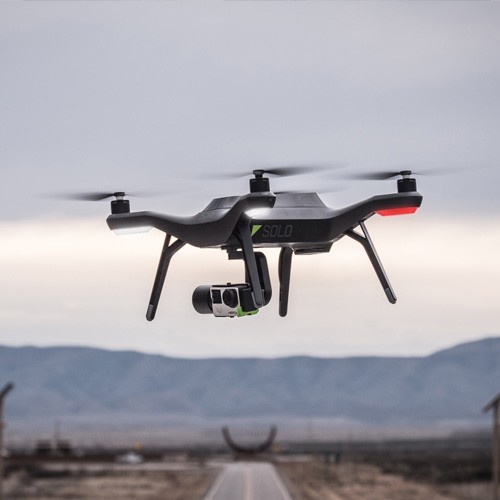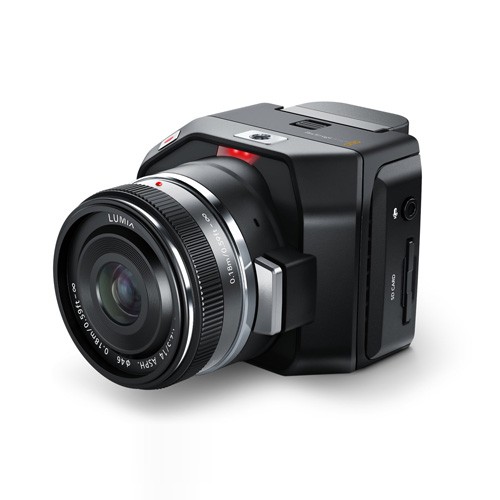The new Solo Quadcopter from 3DR will be released at the end of May. 3DR touts the quadcopter as “the world’s first Smart Drone.” There is a ton of info over at the 3DR website, so I won’t go into the details here, but I’ll discuss some interesting points. It’s fairly clear this product is a direct competitor to the DJI Phantom, but while this post isn’t a side-by-side spec analysis, there are some comparisons drawn.
Technology
The Solo boasts some impressive and forward thinking technology for this particular class of multirotor device.
Firstly, the airframe itself uses a combination of flight controller (running Pixhawk 2 autopilot software) and a 1 GHz ARM Cortex-A9-powered computer (running Linux).
Secondly the controller uses another 1 GHz ARM Cortex-A9-powered computer (running Linux). In addition to regular flight controls, the controller provides HDMI output and full GoPro control, allowing settings to be changed on the fly. It also features two user-definable buttons, haptic feedback, and an on-board screen showing flight telemetry and battery status.
Thirdly, the incredibly enticing computer-assisted cinematography features, enabling precise control over the camera. A single operator can achieve a fair amount of shot types using currently available small multirotors, but freeing up camera control while the aircraft is essentially flying itself on a pre-determined path, truly makes dual crew style shots possible by a single operator. No doubt this is the thinking behind the ‘Solo’ moniker.
It should be noted that these ’smart drone’ features come straight out of the box, not relying of third party developers to build these features as does the Phantom 3.
-

3DR Solo -

Smart Controller
Piece of mind
3DR seem very confident of their technology. For any technical issues resulting in airframe loss / damage, i.e, non-pilot error, they are offering flyaway replacements — not only the airframe, but the gimbal and GoPro too.
As the smart controller is essentially the black box collecting and storing all the data (“500 flight parameters during flight, ten times a second”) even if you loose your airframe, the data is preserved and can even be instantly uploaded to the 3DR technical support team.
This is a very assuring move by 3DR and will certainly put their customer support in a world beating position for these types of devices. Aside from user error, the biggest factor for crashes and flyaways is inevitably the software / hardware symbiosis.
This type of offering will bring more much needed confidence, especially for new users.
Expandability
As I mentioned above, it’s clear this product is a direct competitor to the DJI Phantom. DJI have decided to not support third party cameras such as the GoPro (for the time being at least) on their latest Phantom 3 models, favouring their own camera offerings.
While DJI have opened up third-party software development, where the Solo seems to differ greatly is its open nature regarding hardware expandability, in addition to software development.
Other Cameras
Speaking of opening up hardware expandability, one prospect I’m particularly excited about is the potential to use different cameras. It would be very interesting to see if the Blackmagic Micro Cinema Camera could be utilised by the Solo.
I read on this Facebook post that the Solo’s estimated max. payload is conservatively around 800g. The BMMCC weighs in around 300g. If a capable gimbal was produced and a lightweight lens used, the Solo + BMMCC could conceivably be a real possibility – especially considering the expansion capabilities both the Solo and the BMMCC offer.
-

BMMCC -

Camera Advancements
Conclusion
It’s an increasingly interesting time for multirotor drone technology. In the past few months, I’ve gone from considering an ALIGN M690L, to an Inpsire1, and more recently to a Phantom 3.
Now I’m also considering the 3DR Solo although I’m not sure the Solo’s, albeit useful, enhanced shot capture features would be enough to move me away from my current Phantom 2 / GP4 setup.
The BMMCC’s 13 stop dynamic range capabilities has got me drooling and is certainly on my aerial camera wish list. If I could purchase a highly portable airframe which would carry one with decent endurance – I’ll be all over it.
SUBSCRIBE FOR FRESH CONTENT
Follow me on social media for updates.
